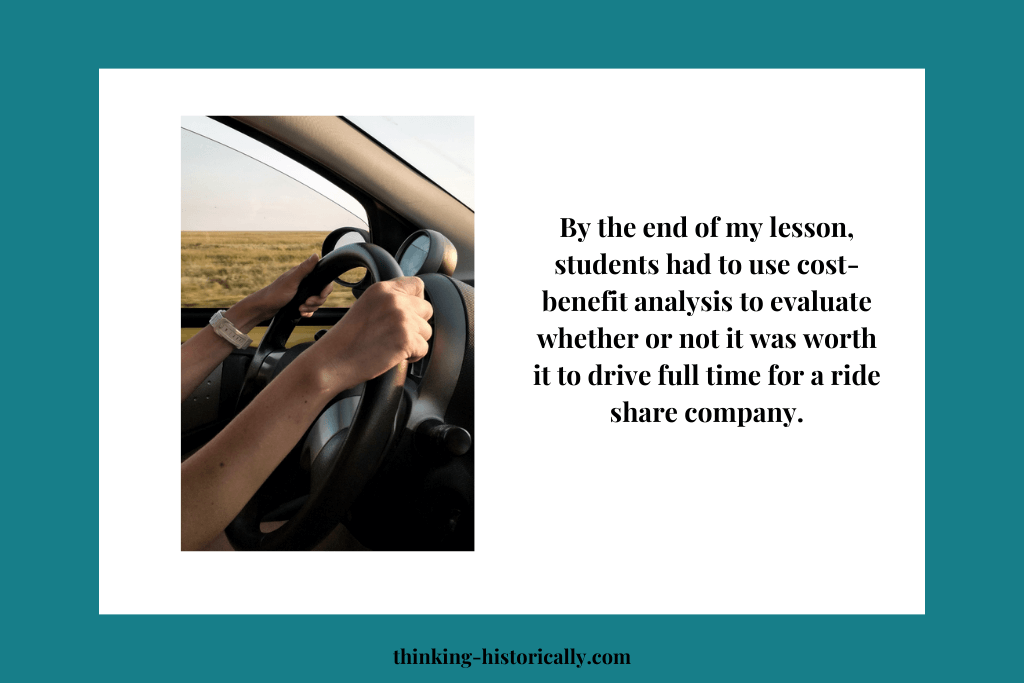Coming up with a cost-benefit analysis lesson for high school students can be a daunting task. Especially when you are up trying to figure out what cost-benefit analysis is the night before you intend to teach this concept to your students (yes, this was totally me). But teaching economics doesn’t have to be this way. In fact, high school economics can actually be fun and engaging for you and the students!
You can make teaching cost-benefit relevant to students’ lives! In fact, students may not know it, but they often make decisions using cost-benefit analysis everyday.
In this post, I’ll go over a cost-benefit high school economics lesson plan that I used in my classroom so that you can recreate it in your own classroom. By the end of my lesson, students had to use cost-benefit analysis to evaluate whether or not it was worth it to drive full time for a ride share company. (If you want to purchase the lesson that I made, you can click here. This lesson comes with a complete lesson plan and ready-to-use student handouts!)

An Engaging Warm-up
To get students interested in the lesson, I gave students the following warm-up question:
- Jason, an 8th grader, wants to open a smoothie stand on his block. Ingredients to make each cup of smoothie costs $2. He uses his allowance to buy 100 cups worth of ingredients, plus a blender ($55), plastic cups ($10), straws ($3) an extension cord ($10), poster board ($2), and colored markers ($5) to make a sign. He wants to attract a lot of people, so he decides to sell his smoothies at $3. It will take around 8 hours to sell all 100 cups. Should he sell smoothies at $3?
This is a great warm-up question to ask because it gets students to make decisions as they think about what will benefit them and their smoothie stands. Without knowing it, students are using cost-benefit analysis!

Give students a few minutes to write their answers and then call on a few students to share their response with the whole class.
Next, explain to students that for this lesson they will use cost-benefit analysis to decide whether or not it is worth it to drive full time for a ride share company.
Cost-benefit Analysis T-chart
Next, explain to students that in cost-benefit analysis, costs are the money or other items/things that you give up when choosing one option over another. Benefits are the money or other items/things you gain when you choose one option over another.
Tell students that when they use cost-benefit analysis they make and use a T-chart to identify the costs and benefits. Display the T-chart below for your students. This T-chart is from the warm-up question. Go over the T-Chart with students and then ask them the following: Do the costs outweigh the benefits of opening a smoothie stand? Give students a few minutes to discuss with a partner before calling on volunteers to share their thoughts with the whole group.

Driving for a Ride Share Company
Next, students will read an article about driving for ride share companies. I had students read an article that was posted on Business Insider. The article can be found using this link. This article covers the costs and the benefits of driving for ride share companies.
Tell students that they will read the article and identify costs and benefits to driving for a ride share company. Students will write the costs and benefits on a T-chart like the one below.

Give students about 10-15 minutes to complete this cost-benefit analysis activity.
If your students have access to the internet, you may have them research other costs and benefits to driving for a ride share company to add to their t-chart.
Applying Cost-benefit Analysis
Finally, students will use their completed t-charts and apply their understanding of cost-benefit analysis to answer the question:
- Is it worth it to drive for a rideshare company full time?
You may give students the following sentence frame to answer the question:
- People (should/should not) drive for a ride share company because the (cost/benefits) outweigh the (cost/benefits).
Remind students that they must use evidence from their t-chart to support their claim.
This is a fun lesson to use with students because it gives students a real-life and relevant example of how cost-benefit analysis is used to make decisions. If you want to purchase the complete lesson, click here!
Happy teaching!



One Response